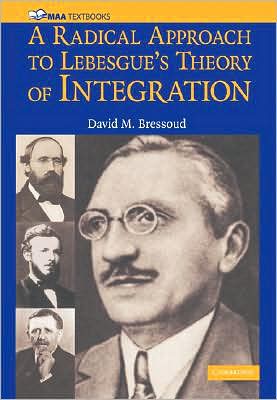

 |

|

The average rating for A Radical Approach to Lebesgue's Theory of Integration based on 2 reviews is 3.5 stars.
Review # 1 was written on 2009-04-12 00:00:00 Zaiman Ceo Zaiman CeoAmazon 2009-04-12. Ahhh, the Lebesgue integral, fearsome opponent of advanced undergraduates everywhere and the first great real departure (if you'll forgive the pun, haha) from high-school mathematics in the standard university curriculum (usually the focus of a second or third semester in real analysis, and almost a necessary prerequisite for functional analysis and study of topological vector spaces (especially the Banach and Hilbert spaces so central to quantum mechanics)). The modern function maps a set (domain) to a set (range); the Lebesgue measure defines "length" (with its natural additivity and translation invariance properties) for sets more complex than those addressed by Riemann -- the domains of the countably additive functions necessitated by modern probability theory, the unbounded sets giving rise to "improper" Riemann integrals, the limits of sequences of functions that underpin nowhere-continuity. Using a Lebesgue measure space (a set, the σ-algebra of Lebesgue-measurable subsets thereof, and the measure itself). The integral is now built up, rather than the Riemannian sum of products of values and infinitesimal subsections (f(x)*(dx)), as the more general sum of products of values, measure and infinitesimal subsets (f(x)*(dμ) == f(x)*μ(dx)). Whew. Unfortunately, I don't really understand any of this at a deep, daily-workable level (then again, how often do continuous probabilities really come up in computing? unfortunately, sequences of functions spring up like digitaria sanguinalis among every field into which I dip my wick (can we say Fast Fourier Transform, boys and girls (mainly boys, sigh)))? But...that's why we read the book. I wish mighty Bartle's The Elements of Real Analysis covered advanced integration, but it pretty much throws in the towel following rigorous coverage of Riemann-Stieltjes, zorn. |
Review # 2 was written on 2016-09-02 00:00:00 William Qualls William Quallsthis book is ok but schutz's book is better. it does a pretty bad job of introducing tensors, i think. some of the exercises are good but there are too many that are very routine. i only read the first 150 or 200 pages though, so i guess keep that in mind. |
CAN'T FIND WHAT YOU'RE LOOKING FOR? CLICK HERE!!!